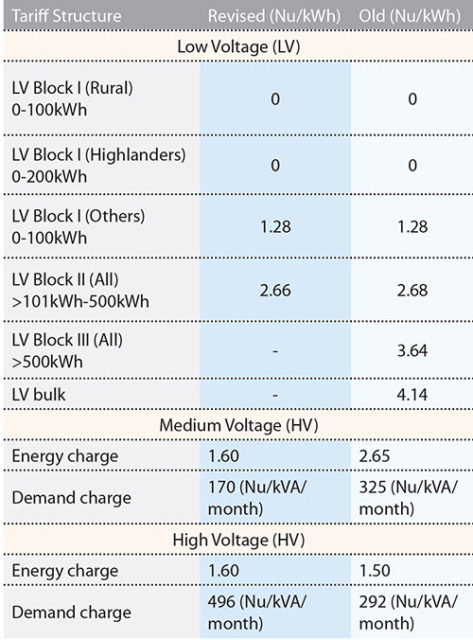Thukten Zangpo
Consumers will pay lesser electricity bills from September this year with the revision of uniform domestic power tariff and government subsidy.
This time the tariff rate comes as a uniform electricity tariff rate at Nu 2.66 per unit of electricity in kilowatt-hour (kWh) for all the consumers.
Under the revised tariff, there will be a decrease in the cost of supply or tariff rate for the LV and MV consumers to ensure affordability and sustainability. But HV will see a slight increase.
The Bhutan Electricity Authority (BEA) notified on August 31 that the government has approved a uniform electricity tariff rate for all consumers based on the approved allocation and application.
The three-year tariff cycle period starts from September 12,2022 to June 30, 2025.
Druk Green Power Corporation (DGPC) and Mangdechhu Hydropower Plant (MHP), as operators of hydropower plants, will bear the cost of generating electricity and determine the generating cost in accordance with tariff determination rules and regulations.
DGPC sells electricity to Bhutan Power Corporation (BPC), a utility company responsible for transmission and distribution.
The BPC categorises its consumers based on electricity consumption into low voltage (LV), medium voltage (MV), high voltage (HV), and wheeling. The wheeling charge is applied for exported energy.

The government has maintained a rural subsidy of 100 units of free electricity and 200 units free per month for the highland communities.
For the free 100 units of electricity for the rural block I consumers, BPC charges the government the actual cost of supply or unsubsidised cost (Nu 2.66 a unit), which comes to Nu 266 per month.
Similarly, for highlanders in Block I who receive free 200 units of electricity, the government will pay Nu 532 as a subsidy to the BPC per month.
Since the government gets royalty energy of 15 percent from hydropower earnings, the government uses this amount to subsidise the cost.
Every year, the government will have to inject Nu 365 million as a subsidy.
According to an official from the economic affairs ministry, the rural people do not have enough paying capacity and subsidies will help them in a very big way.
He also said that the subsidy would also help in reducing the use of liquefied petroleum gas (LPG) and firewood, as the people shift from the use of such fuels to electricity. “We highly hope that people will take up electric cookers to take advantage of our electricity. This will help reduce the dependence on LPG and minimise deforestation due to the reduced use of firewood in rural areas. Such initiatives will also help retain our people in the rural areas and address the issue of rural-urban migrations.”
The tariff revision has also maintained Nu 1.28 per unit of electricity for LV block I (0-100kWh), excluding rural consumers and highlanders. This block includes urban households, commercial shops, and institutions, among others.
For instance, the BPC charges Nu 2.66 per unit of electricity but because of the subsidy of Nu 1.38 per unit, the consumers in the LV block I (0-100kWh) are charged Nu 1.28 per unit.
An official from the BEA said that 100 units of electricity are considered a lifeline block, a basic requirement for households for lighting and cooking and charging phones. “The government has maintained the tariff rate at Nu 1.28 per unit for a long time to make electricity affordable to lower income groups.”
However, all the consumers under the LV category have to pay Nu 2.66 per unit of electricity if the consumption of electricity is more than 100 units.
Earlier, there were different tariff rates for LV block for the consumption of electricity-LV block II (>101-500kWh), the tariff rate was Nu 2.68 per unit, block III (>500kWh) was at Nu 3.64 per unit, and LV bulk at Nu 4.14 per unit.
Suppose a consumer has to pay Nu 2,184 per month for 600kWh of electricity consumption under Block III (>500kWh) old tariff. With the new revision, it will save Nu 588 per month.
There are around 2,20,000 consumers (households) in the country.
The new tariff revision has also reduced the overall cost for MV consumers. The energy charge for MV consumers has been revised to Nu 1.6 per unit from Nu 2.65 per unit and the demand charge has been reduced to Nu 170 kilo-volt-ampere (kVA) per month from Nu 325 kVA.
The energy charge is the electricity BPC buys from DGPC and MHP and demand charge is which BPC charges as network costs for the transmission and distribution lines.
However, the tariff for the HV consumers including ferrosilicon and cement industries has been increased. The energy charge has been increased to Nu 1.6 per unit from Nu 1.5 per unit. The demand charge has also been increased to Nu 496 per kVA per month from Nu 292 kVA per unit.
HV consumers consume more than 70 percent of the electricity generated in the country.
The BEA notified that the DGPC’s cost of supply was revised to Nu 1.34 per kWh from the proposed Nu 1.54 per kWh and Mangdechhu Hydropower Plant’s to Nu 3.64 per kWh from Nu 3.7 per kWh.
In terms of electricity pricing in the country, the domestic electricity tariff policy and tariff determination regulations were put in place to ensure fairness and transparency.


